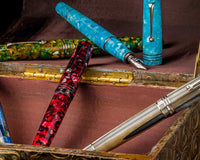Fountain pens may last a lifetime and beyond if they are well-maintained, but even some of the best fountain pens are not impervious to some signs of aging. One of these signs is the tarnishing of a nib. If you’re a vintage fountain pen collector, then this might be something you encounter every so often. Tarnished nibs often work just fine, but they are a bit unattractive as they have lost their shine (unless you prefer pens to have a more worn-in look). You can keep your pens looking their best by polishing them. Here’s everything you need to know.
What is tarnish?
Tarnish occurs when metal is exposed to oxygen, resulting in a thin layer of dullness and discoloration. Fountain pen nibs are constantly exposed to oxygen, making tarnish an inevitable reality for some pens.
Do gold nibs tarnish?

Pure gold is resistant to oxidation and corrosion, meaning it doesn’t tarnish. Why then do even gold-nibbed pens tarnish over time? Any gold that isn’t 24-karat in purity has other metals mixed in to strengthen it and make it more suitable for everyday use. Most fountain pen nibs are 14-karat, 18-karat, or 21-karat gold, which means they are combined with other metals and can be prone to some degree of tarnishing.
Fortunately, tarnish is not as corrosive as rust, so it does not penetrate deep into the metal of the nib but rather sits on its surface. It is also quite easy to remove. All you need is a lightly abrasive material to remove the tarnish while leaving the underlying surface undamaged. This is where polishing your fountain pen nib comes in.
How to polish your fountain pen nib

Polishing your nib is quite easy and straightforward. All you need is a silver polishing cloth, similar to what is used to make jewelry or silverware shine like new.
Take your polishing cloth and place it on the base of the nib near the pen body. Gently wipe towards the tip of the nib. Repeat this process until you’ve wiped off most, if not all, the tarnish. As a safety precaution, you can hold the cloth stationary and move the nib across it. This will minimize the chances of you dropping your pen. It also helps to work over a soft surface, such as a carpet or your couch, in case you do drop your pen.
If you encounter stubborn bits of tarnish on some parts of the nib, then you can polish this area in very small circles. Be most careful when polishing the tip of the nib as you don’t want to damage it. You can also use polishing compounds like Simichrome or a polishing paste from Kaweco, both of which are slightly more abrasive than a polishing cloth. Simply rub a small amount into a soft cloth, then use it to polish the nib. It is important to note that while this compound will not damage golden fountain pen nibs, it can rub off gold-plated nibs and expose the metal underneath.
After polishing you nib, it is always best to clean and wash it before inking it up for use. This way, you will remove any of the polishing compounds and cloth fibers from your pen’s nib.
The Bottom Line
Polishing a nib is a great way to keep it looking new over time. While most tarnish comes off easily enough, some pens that have faced the elements may remain tarnished in some spots. Rather than trying to get it to look perfect and brand new again, we can also accept that the pen has lived through plenty and appreciate it for the writing it can provide. Proper fountain pen maintenance is always the best way to keep your pens looking great and working in excellent condition. This way it will shine for many more years to come.
Happy polishing and happy writing!
Written by EndlessPens Blogger Ramona Kabigting







